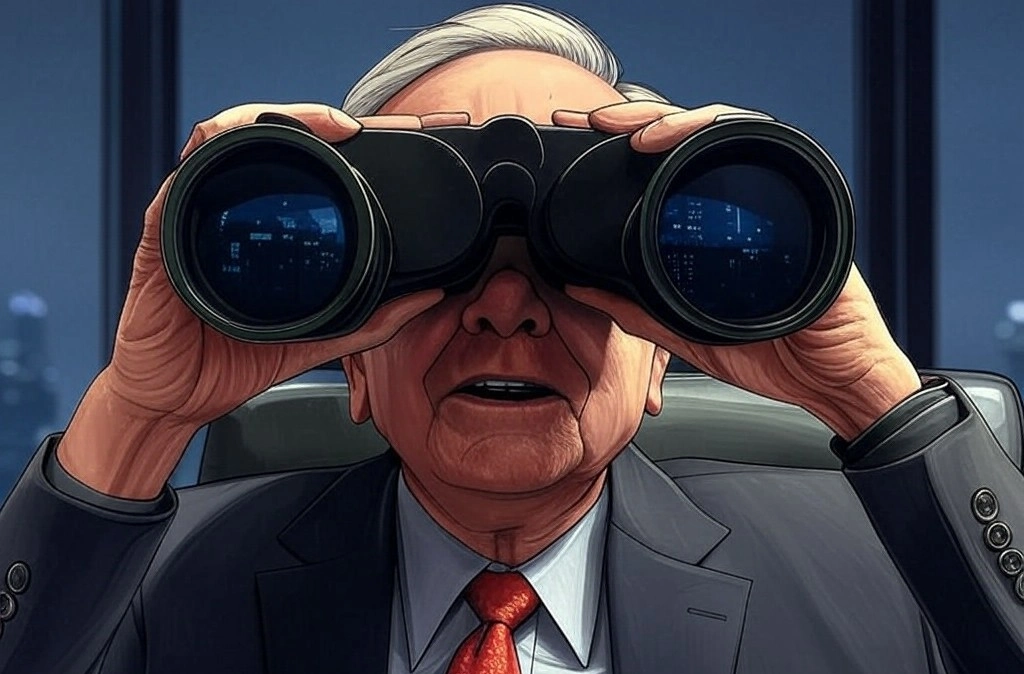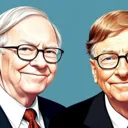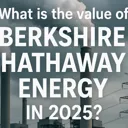Tags: Comments
This fanpage is not officially affiliated with Berkshire Hathaway: Disclaimer
The S&P 500's P/E ratio is currently above 30—a level we’ve seen before, but rarely for long 11. Consider the dot-com bubble in 2000, the housing crisis in 2008, or the stimulus-fueled surge of 2021 during the COVID-19 pandemic. Such lofty valuations suggest lower future returns in the equity market, posing a challenge for Berkshire Hathaway and its massive cash reserves, especially with interest rate cuts expected this year. So, we want to consider the following question: How long until Buffett can make his next big move? And where will it be? Let’s find out!

Introduction
Warren Buffett, often hailed as the "Oracle of Omaha," is renowned for his cautious approach to equities, a strategy that has been underscored by recent activities at Berkshire Hathaway. The conglomerate has been a net seller of stocks, with a notable reduction in its holdings of major companies such as Apple and Bank of America 2. This conservative stance is not without precedent; historically, Berkshire Hathaway's strategic acquisitions have been pivotal, capturing the attention of shareholders and market analysts alike. The anticipation surrounding its next major move is palpable.
In today's economic climate, characterized by high valuations in U.S. equities and, in a historical perspective, persistently low interest rates, investors face a unique set of challenges and opportunities. The current environment demands a keen understanding of market dynamics, as well as the ability to identify undervalued assets amidst a sea of overvaluation. This scenario sets the stage for a discussion on potential future acquisitions and strategic moves by Berkshire Hathaway.
As we explore the possibilities, it's crucial to consider the potential of emerging markets and private company acquisitions. These avenues may offer Berkshire the opportunity to leverage its substantial cash reserves in a manner that aligns with its long-term investment philosophy. Understanding the historical, political, and economic contexts is essential in predicting Berkshire's future strategies, as these factors often guide its investment decisions. The purpose of this article is to delve into when and how Berkshire Hathaway might strike again with a significant acquisition or strategic move.
The Current Landscape of U.S. Equities
The U.S. equities market is currently marked by high valuations, with the S&P 500 trading at a cyclically adjusted PE ratio (CAPE) over 38 1. This level of valuation is reminiscent of the dot-com bubble, raising concerns about the sustainability of current market prices. Historically, each time the S&P 500 reached a CAPE of over 33, it led to a bear market within the next 1.5 years 1. Such high valuations pose significant risks for investors, particularly in an environment where expected returns are low.
Low interest rates have been a key driver of these valuations, as they have encouraged investors to seek higher returns in the stock market. However, this has also led to low expected returns for U.S. equities, with Goldman Sachs predicting an average return of just 3% for the S&P 500 over the next decade 1. This forecast underscores the challenges facing investors in achieving substantial returns in the current market.
Another notable feature of the current landscape is the concentration of the S&P 500. Eight big tech companies, often referred to as the "MegaCap-8," account for over one-third of the index's value, making it more concentrated than it has been in over 100 years 1. This concentration increases the vulnerability of the index to fluctuations in the performance of these companies.
To provide a clearer picture, consider the following table illustrating the forward PE ratios of the S&P 500 and its components 112:
| Index / Component | Forward PE Ratio |
|---|---|
| S&P 500 | 22-25 |
| MegaCap-8 | 29 |
| Median S&P 500 | 19 |
These figures highlight the disparity in valuations within the index, with the "MegaCap-8" trading at significantly higher multiples compared to the median stock.
Warren Buffett's cautious stance on equities is evident, as Berkshire Hathaway has been a net seller of stocks in recent quarters 2. This strategy reflects a prudent approach in an overvalued market, where the potential risks outweigh the rewards. As such, exploring alternative investment opportunities, such as emerging markets and private companies, may offer Berkshire a strategic advantage in navigating this challenging landscape.
So, let's look into emerging markets !
Opportunities in Emerging Markets
In the ever-evolving landscape of global finance, emerging markets (EM) present a compelling opportunity for investors, including those with stakes in Berkshire Hathaway. With EM equities poised to deliver higher earnings per share (EPS) growth than their developed market (DM) counterparts in 2024 and 2025, the allure of these markets is undeniable 4. The historically wide valuation discount of EM equities compared to DM makes them particularly appealing to value investors seeking untapped potential 4.
The expected weakening of the U.S. dollar (USD) further enhances the attractiveness of EM equities. This depreciation is supported by forecasts of lower U.S. economic growth and interest rates, creating a favorable environment for EM investments 4. As the USD weakens, EM currencies are likely to strengthen, boosting the returns on investments in these regions. 2025 is expected to be a strong year: Corporate profits are expected to rise by 12% globally, with the U.S. leading at 14% growth 3.
China, a significant player in the EM landscape, is showing signs of recovery. This revival, coupled with a positive outlook for EM economic growth, positions EM countries to account for a staggering 70% of global GDP growth in the coming years 4. Such growth underscores the strategic benefits of investing in high-quality EM companies with structural growth drivers, a strategy emphasized by financial powerhouses like J.P. Morgan 4. However, China may not be part of Berkshire's playbook because of geopolitical implications, as we have seen for BYD 13. Berkshire has increased its stake in Nubank recently, valued at around $1.2 billion 14. But are there alternatives except Brazil that we have recently covered ↗?
Under President Javier Milei, Argentina is undergoing a dramatic economic shift toward free-market policies, deregulation, and a more business-friendly environment. His government aims to curb inflation, reduce state intervention, and attract foreign investment—conditions that could appeal to Warren Buffett’s value-driven approach. Argentina’s vast natural resources, including energy, agriculture, and lithium, present compelling opportunities at potentially attractive valuations. If Milei’s reforms succeed in stabilizing the economy and restoring investor confidence, Berkshire might see Argentina as an undervalued market with long-term growth potential.
Nevertheless it remains questionable if Berkshire will make a significant move in the emerging markets because of the implied risks with such a transaction. Before we go into a strategy that Berkshire has employed successfully ↗, let us shortly discuss the implications of interest rates for suitable investment opportunities. Yes, this is somewhat redundant but we may not emphasize it enough.
The Role of Interest Rates in Investment Strategy
Interest rates play a pivotal role in shaping investment strategies, and the current monetary policy landscape is no exception. The Federal Reserve's recent rate pause, maintaining the federal funds rate at a 23-year high, reflects its commitment to combating inflation, which remains below the desired 2% target 5. However, the Fed's "dot plot" forecast suggests the possibility of two rate cuts in 2025, a development that could have far-reaching implications for investors 5.
Historically, low interest rates have led to high valuations and low returns in equity markets. This dynamic influences investment strategies, as investors seek to balance risk and reward in a low-rate environment. Future rate cuts could also impact savings and certificate of deposit (CD) rates, potentially altering investor behavior as they search for yield in a changing financial landscape 5.
The relationship between interest rates and asset valuations is well-documented. Changes in rates have historically influenced market dynamics, with lower rates often leading to higher asset prices. For Berkshire Hathaway, which boasts substantial cash reserves, the implications of a low-rate environment are significant. The company could leverage its liquidity to capitalize on opportunities that arise from shifts in monetary policy.
At this moment, the U.S. 10 Year Treasury hovers around 4.5% 15. Make no mistake; in a historical context, this is still a low interest rate regime!
Without further due, let's turn to the strategy that might yield the best results in the upcoming years.
Private Company Acquisitions: A Strategic Avenue
Berkshire Hathaway has long been a beacon of strategic foresight and calculated risk-taking ↗. As public market valuations soar, the allure of private company acquisitions emerges as a compelling alternative for Berkshire, offering a path to negotiate favorable terms and unlock synergies with its existing portfolio. This approach aligns seamlessly with Berkshire's investment philosophy, which emphasizes long-term value creation and operational efficiency; Buffett himself has emphasized the importance of an "assemblage of strengths" in business strategy when it comes to synergy effects 7.
M. Jazib recently outlined an interesting list of America's 10 largest private companies 8:
| Rank | Name | State | Industry | Revenue | Employees |
|---|---|---|---|---|---|
| 1 | Cargill | Minnesota | Food, Soft Beverages, Alcohol & Tobacco | $177 B | 160,000 |
| 2 | Koch Industries | Kansas | Multi-company | $125 B | 120,000 |
| 3 | Publix Super Markets | Florida | Food Markets | $54.5 B | 250,000 |
| 4 | Mars | Virginia | Food & Drink | $47 B | 140,000 |
| 5 | H-E-B Grocery Company | Texas | Food Markets | $43.6 B | 145,000 |
| 6 | Reyes Holdings | Illinois | Food, Drink & Tobacco | $40 B | 36,000 |
| 7 | Enterprise Mobility | Missouri | Travel & Leisure | $35 B | 90,000 |
| 8 | C&S Wholesale Grocers | New Hampshire | Food, Drink & Tobacco | $34.65 B | 15,000 |
| 9 | Love's Travel Stops & Country Stores | Oklahoma | Convenience Stores & Gas Stations | $26.5 B | 40,000 |
| 10 | Southern Glazer's Wine & Spirits | Florida | Food, Drink & Tobacco | $26 B | 24,000 |
Two companies that might stand out as potential acquisition targets are Mars, Inc. and Love's Travel Stops. Both companies are privately held and have demonstrated robust growth and market presence. Mars, Inc., with its extensive portfolio of confectionery, pet food, and other food products, presents a unique opportunity for synergies with Kraft Heinz, a company in which Berkshire holds a significant stake. The potential for operational efficiencies and market expansion is substantial, particularly in the realm of product innovation and distribution networks. By integrating Mars' strong brand portfolio with Kraft Heinz's global reach, Berkshire could capitalize on cross-selling opportunities and enhance its footprint in the consumer goods sector.
Similarly, Love's Travel Stops offers a strategic fit with Berkshire's existing investment in Pilot Travel Centers. The potential benefits of consolidation and scale are evident, as both companies operate within the energy and retail sectors. By leveraging Love's extensive network of travel stops and convenience stores, Berkshire could enhance its market position and drive growth through operational synergies and improved supply chain efficiencies.
Historically, Berkshire Hathaway has excelled in identifying and acquiring private companies that align with its investment philosophy. The acquisitions of companies like BNSF Railway and Precision Castparts serve as testament to Berkshire's ability to integrate and grow businesses while maintaining their unique cultures and operational strengths. These examples highlight the potential benefits and challenges of private company acquisitions, underscoring the importance of strategic alignment and long-term vision.
In addition to financial and operational considerations, the role of succession planning cannot be overlooked in private company acquisitions 6. Berkshire's expertise in facilitating ownership transitions could prove invaluable, particularly in cases where family-owned businesses like Mars, Inc. are involved. By exploring all succession options and crafting bespoke plans, Berkshire can ensure business continuity and preserve the legacy of acquired companies while maximizing value for shareholders.
Let's have a look at the two examples from the list: Mars and Love's.
Mars, Inc.: A Sweet Opportunity
Founded in 1911, Mars, Inc. has grown into a global powerhouse with a diverse portfolio of confectionery, pet food, and other food products. With annual sales of $45 billion in 2022 and a presence in over 80 countries, Mars is the fourth-largest privately held company in the U.S. The company's iconic brands, including Snickers, Milky Way, and 3 Musketeers, have become household names, contributing to its strong market position and brand loyalty 9.
The potential synergies between Mars, Inc. and Kraft Heinz are significant. Both companies operate in the consumer goods sector, and a strategic acquisition could unlock opportunities for product innovation and market expansion. By leveraging Kraft Heinz's extensive distribution network, Mars could introduce its products to new markets and enhance its global reach. Additionally, the combined expertise in marketing and product development could drive innovation and create new growth avenues for both companies.
Mars, Inc.'s strong brand portfolio aligns well with Berkshire's investment philosophy, which prioritizes long-term value creation and sustainable growth. The company's commitment to quality and innovation resonates with Berkshire's approach to investing in companies with enduring competitive advantages. Moreover, Mars' focus on sustainability and ethical business practices aligns with the growing consumer demand for responsible corporate behavior, further enhancing its appeal as a strategic acquisition target.
However, acquiring a private company with a strong family ownership structure presents unique challenges. The Mars family has maintained control of the company for over a century, and any acquisition would require careful negotiation and alignment of interests. Berkshire's experience in facilitating ownership transitions and preserving company culture could prove invaluable in navigating these complexities and ensuring a smooth integration.
To illustrate the potential synergies, consider some rough financial metrics and market positions of Mars, Inc. and Kraft Heinz:
| Metric | Mars, Inc. (2022) | Kraft Heinz (2022) |
|---|---|---|
| Revenue | $50 billion | $26 billion |
| Global Presence | 80+ countries | 40+ countries |
| Key Products | Confectionery, Pet Food | Packaged Foods, Beverages |
| Brand Strength | Iconic Brands | Established Brands |
The historical success of Berkshire's acquisitions in the consumer goods sector, such as Duracell and Dairy Queen, provides valuable insights into the potential benefits of a Mars acquisition. These investments have not only delivered strong financial returns but also reinforced Berkshire's reputation as a long-term investor focused on building sustainable businesses.
Hence, an acquisition of Mars, Inc. might represent a sweet opportunity for Berkshire Hathaway to enhance its consumer goods portfolio, drive innovation, and create long-term value for shareholders ↗↗. By leveraging its expertise in private company acquisitions and succession planning, Berkshire can navigate the complexities of this strategic investment and capitalize on the synergies between Mars and Kraft Heinz.
Love's Travel Stops: Fueling Growth
Love's Travel Stops, a privately-owned powerhouse in the energy and retail sectors, offers a compelling growth narrative that aligns well with Berkshire Hathaway's investment philosophy. Founded in 1964 by Tom and Judy Love, the company has expanded its footprint to 630 locations across the United States, serving as a vital hub for diesel fuel, gasoline, truck maintenance, and hospitality services. With a robust revenue stream of US$20.6 billion in 2019, Love's ranks as the 10th largest private company in America, according to Forbes 10. Pilot's revenue is in the order of $60 billion ↗.
But wait! In 2010 Pilot was forced to soll 26 locations to Love's to settle antitrust concerns with the Federal Trade Commission 16. So although there might be a huge potential for synergies in operational efficiencies and market expansion, regulatory concerns would probably hinder the case. Both companies dominate the travel stop market, and a merger could streamline logistics, enhance supply chain management, and broaden their service offerings. Such a move would resonate with Berkshire's penchant for businesses boasting durable competitive advantages.
Acquiring Love's Travel Stops could offer Berkshire a strategic foothold in the travel and hospitality sectors, diversifying its portfolio and opening avenues for cross-selling opportunities. However, the acquisition of a private company like Love's, with its strong family ownership structure, presents unique challenges. The Love family retains 100% ownership, and navigating this dynamic requires a nuanced approach to ensure alignment of interests and smooth transition 10.
Berkshire's historical success in other sectors, such as its investments in BNSF and Dairy Queen, offers valuable insights into the potential benefits of a Love's acquisition. These past ventures have demonstrated Berkshire's ability to harness the strengths of established brands, creating long-term value through operational excellence and strategic expansion.
Over time, regulatory conditions might be met and we would see a successful acquisition of Love's!
Warren Buffett's investment philosophy is synonymous with patience and long-term value creation. This approach emphasizes waiting for the right opportunities, even if it means sitting on the sidelines for extended periods. Historical examples of significant Berkshire acquisitions, such as the purchase of Burlington Northern Santa Fe (BNSF), illustrate the value of patience in investment strategy. This acquisition took years to materialize, yet it became one of Berkshire's most successful deals, underscoring the importance of timing and strategic foresight.
Berkshire's substantial cash reserves provide the flexibility to wait for attractive opportunities, even in challenging market environments. This financial strength allows Berkshire to capitalize on market dislocations and distressed opportunities, leveraging its reputation and resources to secure favorable deals. The role of market cycles and economic conditions is pivotal in shaping Berkshire's investment strategy, with historical data offering insights into past market dynamics and future potential.
Maintaining a disciplined investment approach is crucial, especially in avoiding the temptation to overpay for assets in an overvalued market. Historical anecdotes, such as Buffett's decision to pass on the tech bubble of the late 1990s, highlight the value of patience and discipline in achieving long-term investment success. By adhering to these principles, Berkshire is well-positioned to navigate future market challenges and capitalize on emerging opportunities, ensuring continued growth and profitability.
The potential acquisition of Love's Travel Stops and the unwavering patience of a long-term investor like Warren Buffett illustrate the strategic foresight and disciplined approach that have defined Berkshire Hathaway's success.
Conclusion
The quest for Berkshire Hathaway to strike gold again hinges on a multifaceted understanding of the current economic landscape and the strategic opportunities it presents. As we have explored, the U.S. equities market is currently characterized by high valuations and low expected returns, compelling Berkshire to adopt a cautious stance in its investment strategy ↗. This prudent approach is not merely a reaction to market conditions but reflects Buffett's long-standing philosophy of waiting for the right opportunities to emerge.
Emerging markets offer a promising avenue for growth, with their potential for higher earnings per share (EPS) growth compared to developed markets, coupled with a historically wide valuation discount. The anticipated weakening of the U.S. dollar further enhances the attractiveness of these investments, positioning Berkshire to leverage its substantial cash reserves in a strategic manner.
Moreover, the potential for private company acquisitions, such as Mars, Inc. and Love's Travel Stops, underscores the strategic avenues available to Berkshire Hathaway. These companies not only align with Berkshire's investment philosophy but also present opportunities for operational synergies and long-term value creation. The historical success of Berkshire's acquisitions in the consumer goods and energy sectors serves as a testament to the potential benefits of these strategic investments.
As shareholders, it is essential to maintain an optimistic outlook regarding Berkshire's future prospects. The company's strong financial position and strategic acumen position it well to navigate the complexities of the current market environment. By staying informed about Berkshire's activities and supporting the company's long-term vision, shareholders can contribute to its enduring success.
References
-
1 Index Fund to Buy That Could Produce Total Returns 5 Times Better Than the S&P 500, According to Certain Wall Street Analysts | The Motley Fool - www.fool.com ↩↩↩↩↩
-
Warren Buffett Is Out of Step With Markets. Berkshire Hathaway Keeps Selling Stocks. - www.barrons.com ↩↩
-
Global Equity Views 1Q 2025 - am.jpmorgan.com ↩
-
Here's What Markets Now Expect for 2025 Fed Rate Cuts—And What It Means for Savings and CD Rates - www.investopedia.com ↩↩↩
-
What is the succession plan for your business? - www.inverness-courier.co.uk ↩
-
The Dangerous Allure of Synergy, per Warren Buffett - Tennessee Valley Group, INC - tnvalleygroup.com ↩
-
List of Top 10 Largest Private Companies in US 2024 - www.jagranjosh.com ↩
-
Mars Inc. - Wikipedia - en.wikipedia.org ↩
-
Love's - Wikipedia - en.wikipedia.org ↩↩
-
S&P 500 PE Ratio - www.multpl.com ↩
-
S&P 500 PE Ratio with Forward Estimate Charts, Data - www.gurufocus.com ↩
-
Warren Buffett’s Berkshire Hathaway dumps BYD shares following rise in trade tension over Chinese EVs | CNN Business - edition.cnn.com ↩
-
Warren Buffett’s Berkshire Hathaway Increases Holdings in Brazilian Digital Bank Nubank – Crypto News Bitcoin News - news.bitcoin.com ↩
-
Check out 's stock price (US10Y) in real time - www.cnbc.com ↩
-
Pilot Flying J - Wikipedia - en.wikipedia.org ↩











